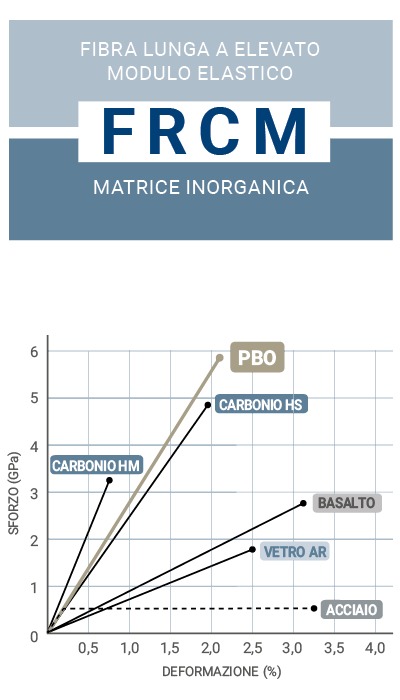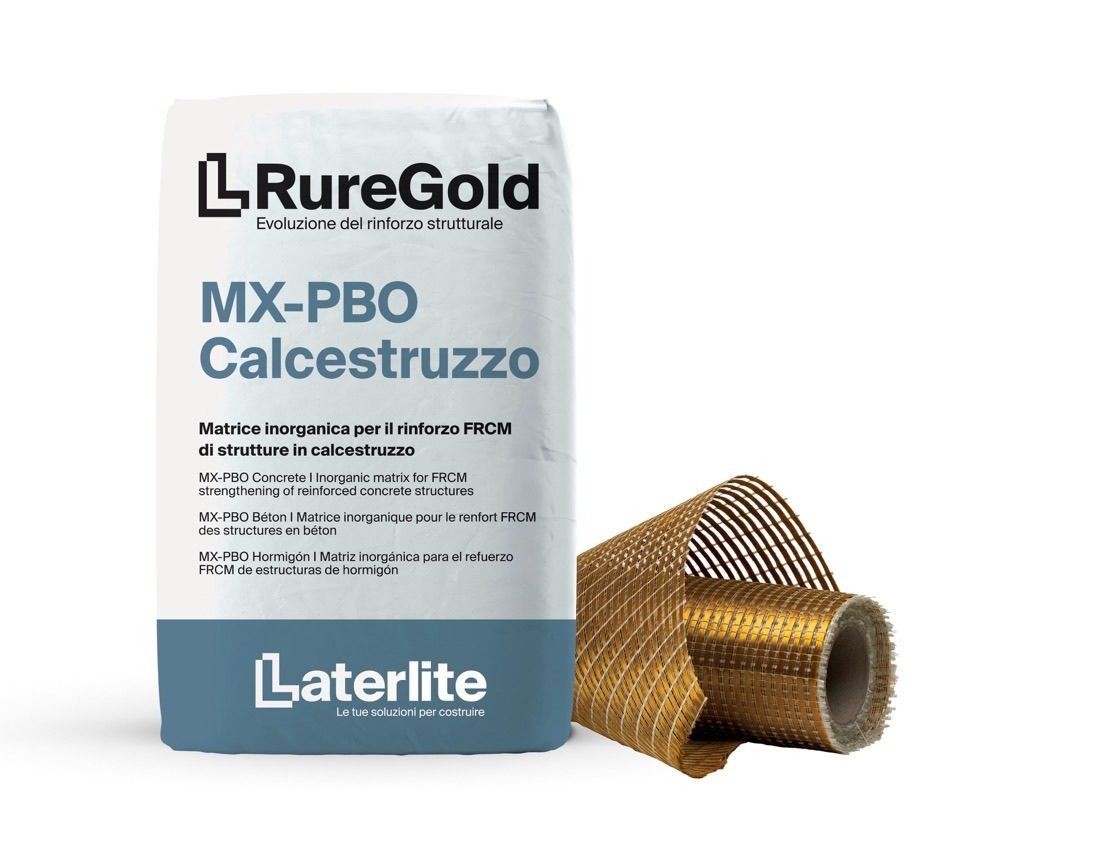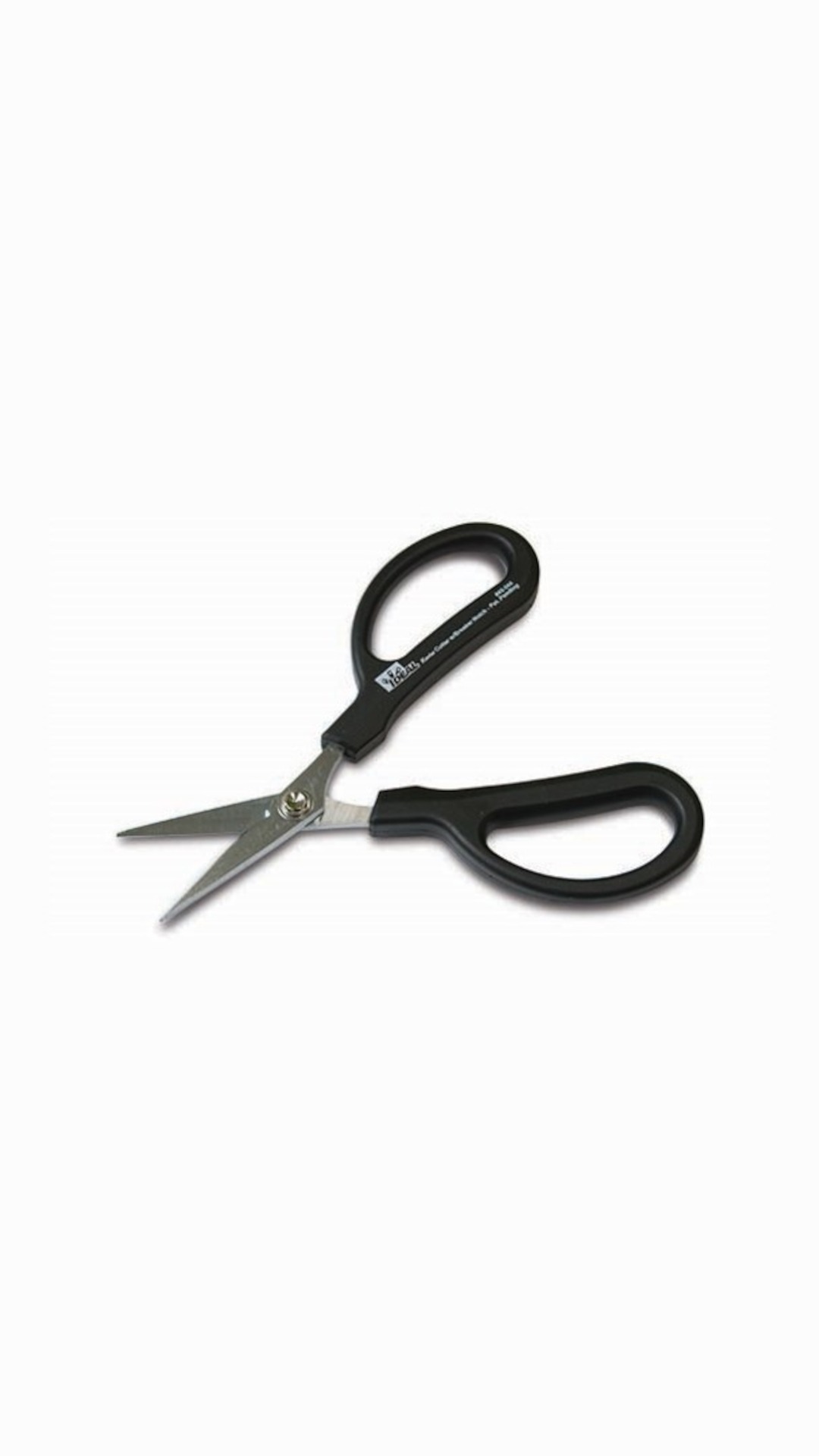Structural strengthening systems
with composite FRCM materials
Ruregold structural strengthening systems use two different types of fibres, carbon and PBO (poly-paraphenylenebenzo-bisoxazole), both synthetic materials with high mechanical performance properties able to absorb the stresses generated by overloads and exceptional events, such as earthquakes. Compared to carbon fibres, PBO fibres used for FRCM carbon systems have 20% greater tensile strength and 15% greater modulus of elasticity.
FRCM (Fibre Reinforced Cementitious Matrix) structural strengthening systems consist of the union a high-performance long fibre and a stabilised inorganic matrix used as an adhesive, replacing the epoxy resins of traditional FRP systems.
Ruregold has introduced a global innovation in the field of structural strengthening by patenting several FRCM strengthening systems
, each of which has been specifically developed to meet the needs of structural strengthening
on various existing structures, such as reinforced concrete and masonry structures.
The special mortars are formulated to match each type of mesh reinforcement system, thus ensuring effective bonding for both the structural fibres of the mesh and to materials constituting the base screed, guaranteeing the high reliability of the structural strengthening.

Ruregold composite strengthening systems use woven structural fibres with a specific geometry to guarantee greater versatility of use or, in other words, an increased capacity to handle stresses, even in the most complex load situations, such as combined axial and flexural forces of columns, shear strength of panels, bending and shear of beams, and actions inside and outside the plane.
Advantages of FRCM strengthening systems:
Application on damp substrates
Fire resistant
Vapour permeability
Non-toxic matrix
Resistant to high temperatures
Resistant to freeze/thaw cycles
Ease of application
Eco-friendly
Compatible with masonry
Ductility
Passive protection
Reversible
FRCM: anti-seismic strengthening
Properties of Ruregold’s FRCM structural strengthening
The purpose of implementing structural strengthening in a seismic zone is to retrofit existing structures so they are able to withstand the intensity of the expected seismic activity. Composite materials are particularly suitable for this purpose since they are resistant, lightweight and easy to apply, which is particularly important in critical areas of the structure that may be difficult to reach.
The strategy of seismic retrofit interventions is aimed at eliminating the brittle fracture mechanism of individual load-bearing structural elements and the collapse mechanisms associated with the slabs, as well as improving the overall deformation capacity of the structure.
In reinforced concrete structures this requirement is usually met by increasing the ductility of the plastic hinges and obtaining box action in load-bearing masonry elements, so as to render them more resistant to horizontal actions, eliminate the orthogonal thrusts on the load-bearing walls (piers) and connect the perpendicular load-bearing elements to each other.
The deformation capacity of the individually strengthened element and the adhesion of the element to the structure are of fundamental importance for the effectiveness and reliability of seismic retrofits. Ruregold’s FRCM systems guarantee these characteristics even in extreme conditions, when cracks are forming in the support.
Application of Ruregold structural strengthening with inorganic matrix
Preparing the base screed
The base screed must be structurally sound, clean, free of dust, loose parts and without any contaminants, such as paints, release agents, etc. In the presence of macroscopic surface defects or irregularities, use a repair mortar suitable for the nature of the base screed in order to fill irregularities and render the surface smooth again. Round any edges to a radius of curvature of 2 cm.

Implementing the Ruregold system.
Saturate the base screed and, after ensuring there is no surface water present, apply the first coat of the matrix (approx. 3/5 mm) using a smooth metal float. Embed the mesh into the mortar, applying pressure with the float until the matrix begins to emerge through the openings in the mesh. Apply the second coat of inorganic matrix (between 3 and 5 mm) so as to cover the mesh completely. Overlay by approx. 30 cm at the junction points.

Applying a fibre connector, if necessary
In some configurations it may also be necessary to insert PBO fibre connectors, to bind the system to the structure. Once a hole has been made in the supporting structure, fill it with the appropriate mortar and insert the joint. The free end of the joint should be opened, spread out in a fan shape on the surface of the mortar covering the strengthening mesh, and then covered with the appropriate Ruregold mortar.

Characteristics of FRCM systems
The uniaxial tensile stress-strain relationship of FRCM systems differs from that of FRP systems with organic matrices. In fact, in terms of behaviour, FRP systems occupy an intermediate position, between organic matrices - typically epoxy resins - and strengthening fibres, with linear elastic stress-strain relationship characteristics. Thanks to their innovative design with respect to the more established FRP systems, the stress-strain relationship of FRCM systems is characterised by an initial phase, during which the principal role is played by the contribution of the inorganic matrix/mortar plays, this is followed by a cracking phase within the matrix itself and, lastly, the residual contribution of the dry mesh. This behaviour is evidence of the pseudo-ductility of FRCM systems with respect to FRP systems, which translates to an advantage in terms of the local ductility of strengthening material when applied to the structural element on which the work is to be carried out. This local ductility also has positive effects when used to determine global system ductility, an approach applied to all the structural elements that need to dissipate energy and possess the capacity to deform when subjected to high load conditions, for example, seismic activity.

In order to compare the deterioration of the mechanical performance of concrete elements (reinforced and unreinforced) in response to temperature increases, flexural strength was selected over compressive strength as the significant parameter, since it is more sensitive to deterioration cause by heat. As can be seen in the graph on the right, as the temperature rises and, in particular, once it exceeds 130°, there is a noticeable deterioration in mechanical performance. While they are also affected temperature increases, FRCM strengthening systems retain their efficacy in terms of the increase in flexural strength with respect to unstrengthened concrete at the same temperature. With respect to ambient temperature, the strengthening system is able to counter the phenomenon of de-cohesion between aggregates and cement paste, which is the cause of loss of strength of unstrengthened concrete.

DT 200 R1 2013 (National Research Council) underlines how, as temperatures rise, epoxy resins begin to transition from a glassy to a visco-elastic state, resulting in deterioration of their adhesive properties and, hence, the mechanical performance of the FRP system. Moreover, in order to determine the environmental temperature at which the strengthening is efficacious, it is necessary to subtract 15° from the glass transition temperature of the resin (Tg) declared by the manufacturer in the technical specification. This means that, if the declared value of Tg is 50°C, the maximum environmental temperature at which the efficacy of the FRP strengthening system is guaranteed is 35°C.
When subjected to the reaction to fire test, in accordance with the applicable European standard, UNI EN 13501-1, Ruregold’s FRCM system was certified as at least Class B-s1,d0. This means that it does not cause toxic fumes and does not form incandescent drops that are potentially very hazardous for people during a fire. All FRP systems, on the other hand, have been certified in class "E", because they use an organic adhesive that contributes to the generation and/or propagation of fire and therefore require appropriate protection.
Ruregold’s FRCM (Fibre Reinforced Cementitious Matrix) strengthening systems maintain the specified performance properties independently of the Relative Humidity (RH) and the environmental temperature, in contrast to FRP systems, which only guarantee such properties under standard thermo-hygrometric conditions (20°C and 50% R.H.) The results of a durability test carried out at the ITC-CNR Laboratory of S. Giuliano Milanese show how much environmental conditions influence the mechanical performances of FRP structural strengthening systems, as can be seen from the graphs on the right. Results similar to the ones obtained at the ITC-CNR Laboratory were also obtained at MIT in Boston and the University of Edinburgh. The experimentation has demonstrated that, in the case of FRP systems, the presence of moisture on the surface of the structure modifies the type of break from "cohesive", i.e. within the support, to "adhesive", i.e. At the interface between the support and the strengthening. It has also been observed that prolonged exposure to moisture causes progressive deterioration of mechanical shear resistance and flexural strength, which tends to accelerate as the temperature increases in the interval between 73-104°F (23-40°C).















